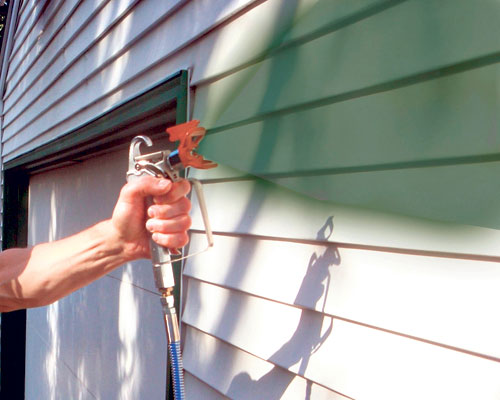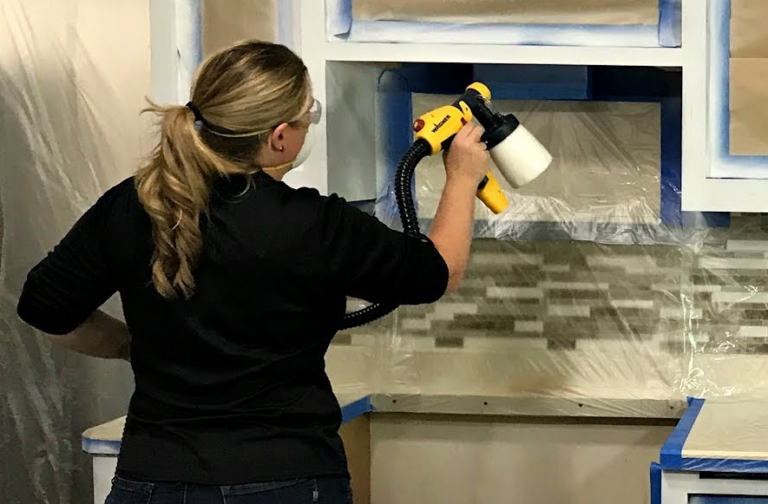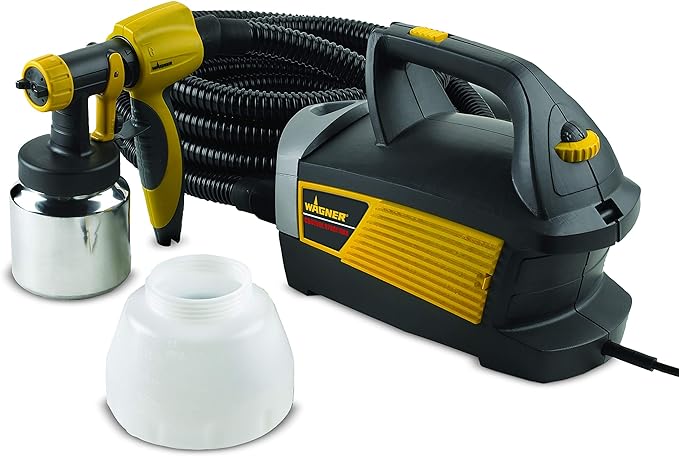Best Paint For Airless Sprayer – Airless, Pneumatic, HVLP Paint Sprayers: Types, Techniques!
Painting with a sprayer can significantly improve the efficiency and finish of any painting project, making it an appealing choice for both professionals and DIY enthusiasts. Unlike traditional brushes and rollers, paint sprayers allow for a more even application, reducing the likelihood of streaks and brush marks.
They are versatile tools, capable of handling a variety of surfaces and materials, from large walls to intricate furniture. Whether you’re looking to rejuvenate a room’s appearance or tackle a more complex project, understanding how to use a paint sprayer effectively can help you achieve a high-quality, professional-looking finish.
What kind of paint do you use in a paint sprayer?
Choosing the right paint for your paint sprayer is crucial to achieving the best results. Typically, latex paints are popular for most home projects due to their durability and ease of cleanup. However, oil-based paints are also commonly used, especially for outdoor surfaces and furniture, as they offer a smoother finish and greater resistance to the elements. It’s important to check the paint’s viscosity, as thicker paints might require thinning to work efficiently with the sprayer. Additionally, always ensure the paint is compatible with your specific sprayer model to avoid clogging and uneven application.
Which type of Paint Sprayer suits you best?
Selecting the ideal paint sprayer depends on the scope and nature of your project. Airless paint sprayers are perfect for large surfaces and exterior projects, providing a fast, even coat with high-pressure delivery. For more detailed work, such as cabinetry or furniture, High Volume Low Pressure (HVLP) sprayers offer precision with minimal overspray. Compressed air sprayers, while less common for home use, provide an excellent finish for automotive and industrial applications.
Assess your needs, considering factors like project size, desired finish, and the type of paint being used, to determine which paint sprayer will best suit your requirements.
Which is the best paint for airless paint sprayers?
The best paint for airless paint sprayers is typically high-quality latex or acrylic paint due to their ease of application and durability. These paints are well-suited for both interior and exterior surfaces, providing excellent coverage and a smooth finish. When using an airless sprayer, it’s essential to ensure the paint is adequately thinned to prevent clogging and achieve a consistent spray pattern. Some brands also offer paints specifically formulated for airless spraying, which can further enhance performance and results. Always refer to the paint manufacturer’s recommendations to ensure compatibility with your airless sprayer.
Does airless sprayer waste paint?
Airless sprayers can be more efficient in terms of time and coverage compared to traditional painting methods, but they do tend to use more paint. This is primarily due to overspray and the need to maintain a consistent flow to achieve an even coat. While some paint is wasted during the priming process and when cleaning the sprayer, the overall finish and speed of application often outweigh the slightly higher paint consumption. Using proper techniques, such as adjusting the spray pattern and maintaining the correct distance from the surface, can help minimize paint waste.
How to use an airless paint sprayer for fine finishes?
Achieving fine finishes with an airless paint sprayer involves careful preparation and technique. Start by selecting a fine spray tip, which allows for more controlled and precise application. Ensure the paint is properly thinned and strained to prevent clogs. Test the spray pattern on a piece of cardboard or scrap material to adjust the pressure and achieve the desired finish. Maintain a steady hand and consistent distance from the surface, applying the paint in smooth, overlapping strokes. For intricate or detailed areas, consider using a lower pressure setting to reduce overspray and achieve a finer finish.
Do you need a second coat with your airless paint sprayer?
Whether a second coat is needed when using an airless paint sprayer depends on the type of paint, the surface being painted, and the desired finish. Airless sprayers typically apply paint evenly and with good coverage, often resulting in a satisfactory finish with just one coat, especially with high-quality paints. However, for surfaces with strong color contrasts or in cases where a more durable finish is required, a second coat might be necessary. Always allow the first coat to dry thoroughly before assessing whether additional coverage is needed to achieve the best results.
It takes an average of 1–2 hours for the paint to dry before another layer of spray paint can be applied under ideal temperature conditions, ranging from about 65 to 80 degrees.
Ideal temperature conditions for applying a second layer of spray paint range from 65 to 80 degrees Fahrenheit. Under these conditions, paint generally dries within 1-2 hours, making it suitable for additional coats. Ensuring the paint has dried sufficiently before applying another layer is crucial for achieving a smooth, even finish. Factors such as humidity, ventilation, and the type of paint used can also affect drying times. Always follow the manufacturer’s recommendations regarding drying times and conduct a quick touch test in a hidden area to confirm the paint is ready for another coat.
Make sure your paint has dried sufficiently for additional coats by conducting a test in a hidden area.
Before applying additional coats of paint, it is essential to ensure the initial layer has dried thoroughly. To do this, perform a quick touch test in a hidden or inconspicuous area. Lightly touch the surface to check if the paint feels dry and firm. If it is still tacky or soft, allow more time for drying to prevent smudging or uneven application. This step helps to avoid potential issues such as peeling, blistering, or an uneven finish. Adhering to recommended drying times and conditions will ensure a professional and durable result.
Is it OK to leave paint in my airless paint sprayer overnight?
Leaving paint in an airless paint sprayer overnight is generally not recommended, as it can lead to clogs and damage to the sprayer. Paint can dry and harden inside the sprayer components, making cleanup difficult and potentially affecting the sprayer’s performance. If a pause in work is unavoidable, follow the manufacturer’s guidelines for short-term storage, such as sealing the paint container and covering the sprayer tip. For longer breaks, it is best to clean the sprayer thoroughly, ensuring all paint is flushed out to maintain the equipment’s longevity and functionality.
How to thin paint for different types of paint sprayers?
Thinning paint for different types of paint sprayers is essential to ensure a smooth application and prevent clogging. For airless sprayers, use a 10-15% dilution with water for latex paints or mineral spirits for oil-based paints. HVLP (High Volume Low Pressure) sprayers typically require a thinner paint consistency, so a 20-30% dilution might be necessary. Always mix thoroughly and strain the paint to remove any impurities. It’s crucial to follow the manufacturer’s guidelines for the specific sprayer and paint being used, as improper thinning can affect the quality of the finish and the performance of the sprayer.
What Is the Best Interior Paint For Spraying Your Walls and Ceilings?
The best interior paint for spraying walls and ceilings is a high-quality, low-VOC (volatile organic compounds) latex paint. These paints are durable, provide excellent coverage, and are easy to clean. They also dry quickly and have a low odor, making them suitable for indoor use. Look for paints specifically formulated for spraying, which tend to have a smoother consistency and fewer solids, reducing the likelihood of clogs and ensuring an even finish. Brands like Sherwin-Williams, Behr, and Benjamin Moore offer excellent options tailored for use with spray equipment.
Why It’s Crucial to Choose the Best Paints for Spray Guns
Choosing the best paints for spray guns is crucial to achieving a professional and durable finish. High-quality paints are designed to flow smoothly through the sprayer, reducing the risk of clogs and ensuring consistent coverage. They also adhere better to surfaces, providing a more uniform and long-lasting finish. Inferior paints may contain impurities or have inconsistent viscosity, leading to uneven application, increased overspray, and a less satisfactory result. Investing in good-quality paint not only enhances the appearance of your project but also extends the life of your spray equipment by minimizing maintenance issues.
Choosing a Paint Sprayer for Your Interior Space: Airless Sprayers or HVLP?
Choosing between an airless sprayer and an HVLP sprayer for your interior space depends on the nature of your project. Airless sprayers are ideal for large areas, such as walls and ceilings, due to their speed and ability to handle thicker paints. They provide a high-pressure, even coat but can produce more overspray. HVLP sprayers, on the other hand, are better suited for detailed work and fine finishes, offering precision with minimal overspray. They work well with thinner paints and are perfect for trim, furniture, and cabinets. Consider your project size and desired finish when selecting a sprayer.
Airless Paint Sprayer
Airless paint sprayers are powerful tools designed for large-scale painting projects. They operate by pumping paint at high pressure through a hose and out of a tiny hole in the spray tip, creating a fine mist that covers surfaces quickly and evenly. This type of sprayer is highly efficient for covering large areas, such as walls, ceilings, and exterior surfaces. Airless sprayers can handle a variety of paint types, including latex and oil-based paints, without the need for significant thinning. They are ideal for professional painters and serious DIY enthusiasts seeking to complete projects rapidly and with professional-quality results.
HVLP Paint Sprayer
HVLP (High Volume Low Pressure) paint sprayers are designed for precision and control, making them perfect for detailed work. These sprayers use a high volume of air at low pressure to atomize the paint, resulting in less overspray and a finer finish. HVLP sprayers are ideal for painting trim, furniture, cabinets, and other intricate surfaces where a smooth, professional finish is required. They work best with thinner paints, such as varnishes and lacquers. While they may take longer to cover large areas compared to airless sprayers, their precision and efficiency in reducing paint waste make them a popular choice for detailed projects.
How to Spray Paint Interior House Walls and Ceilings
Spray painting interior house walls and ceilings requires careful preparation and technique. Begin by covering floors, furniture, and fixtures with drop cloths and masking tape to protect them from overspray. Use a high-quality interior paint and ensure it is adequately thinned if necessary. Start spraying from the top, working your way down in smooth, overlapping strokes to avoid streaks and ensure even coverage. Maintain a consistent distance from the surface and keep the sprayer moving to prevent paint buildup. For the best results, use an airless sprayer for large areas and switch to an HVLP sprayer for detailed work.
Prep the Area for Spraying Interior Paint
Properly prepping the area is crucial for a successful spray painting project. Start by removing or covering furniture, fixtures, and flooring with plastic sheeting or drop cloths. Clean the surfaces to be painted to remove dust, dirt, and grease, ensuring better paint adhesion. Repair any holes or cracks with spackling compound and sand smooth. Use painter’s tape to mask off edges, trim, and any areas that should not be painted. Ensure good ventilation by opening windows and using fans if needed. Taking the time to prep thoroughly will result in a cleaner, more professional finish and save time on touch-ups.
Using a Spray Painter Indoors
Using a spray painter indoors requires attention to detail and safety precautions. Ensure the room is well-ventilated to avoid inhaling fumes by opening windows and using exhaust fans. Cover all surfaces not being painted with drop cloths and plastic sheeting to protect from overspray. Wear protective gear, including a mask, goggles, and gloves. Choose the right sprayer for your project—airless for broad surfaces and HVLP for detailed work. Practice on a piece of cardboard to adjust the spray pattern and pressure. Maintain a consistent distance from the surface and use smooth, even strokes for the best results.
Conclusion
In conclusion, paint sprayers offer an efficient and professional way to complete painting projects, from large walls to intricate details. Understanding the different types of sprayers—airless and HVLP—helps in selecting the right tool for your specific needs. Proper preparation, including thinning the paint and prepping the area, ensures optimal results. By following best practices for using a paint sprayer indoors, you can achieve a smooth, even finish with minimal waste. Investing time in choosing quality paints and maintaining your equipment will enhance your painting experience and the longevity of your sprayer.
F.A.Q.
What types of paint can be used in a sprayer? Latex, acrylic, and oil-based paints are commonly used.
How do I clean my paint sprayer? Flush with the appropriate solvent, such as water for latex paint or mineral spirits for oil-based paints.
Can I use a paint sprayer for small projects? Yes, HVLP sprayers are ideal for detailed, small-scale projects.
Is it necessary to thin all paints for spraying? Not always, but many paints, especially thicker ones, require thinning.
How do I prevent overspray? Use proper technique, maintain the correct distance, and select the appropriate spray tip.
Can I leave paint in the sprayer overnight? It is generally not recommended; clean the sprayer to prevent clogs and damage.

Hi there! I’m Mike Jones, a passionate tattoo artist who loves exploring new painting techniques and tools. When I’m not in the studio creating new tattoos, you can find me writing for the blog PaintPro Tools, where I share my expertise and insights about airless paint sprayers.
My journey in art began early on with a love for painting and drawing, which eventually led me to the world of tattooing. As a tattoo artist, I’ve learned to appreciate the precision and quality of the tools I use, which naturally sparked my interest in airless paint sprayers.
At PaintPro Tools, I write about everything related to airless paint sprayers. My goal is to demystify these tools by providing practical tips, detailed tutorials, and honest reviews. I aim to help you understand how these sprayers work, which options are the best on the market, and how to get the most out of them for your projects.
I love interacting with readers and other painting enthusiasts. If you have any questions about tattoos, airless paint sprayers, or any other art-related topics, feel free to reach out to me.
https://paintprotools.pro/contact/
Thank you for visiting PaintPro Tools. Let’s create something amazing together!



